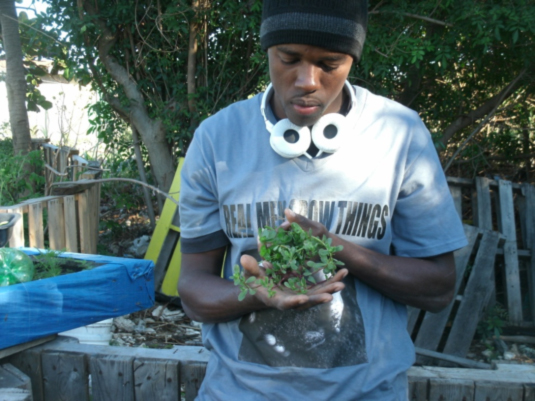
The author holding Portulaca oleracea (Common Purslane, also known as Verdolaga, Pigweed, Little Hogweed, or Pusley, and Moss Rose
|
“Purslane” has more Omega 3 than any other
leafy vegetable plant to date
Weeding for me is an
enjoyable experience for one it means that I will be cleaning the garden
and listening to great music or lecture series. But aside from that
I actually spend most of my time eating weeds. I know you are probably
thinking I’m crazy. Go ahead, I have heard it all before. What’s really crazy is that we don’t always know the connection we have with plants we have been pulling out of the garden or our
lush lawns, and what their consumption can mean for us.
I have spent countless
hours informing my friends of plants and how important everything in
nature really is and thankfully a lot of them actually pay attention.
So let’s talk about
one of the many weeds you will encounter on your property. Better
yet let’s talk about one in particular and it's called Purslane.
Purslane is a
native of India and Persia but has moved throughout the world.
In many places this weed is being considered the plant that will
surpass spinach in the market. You may very well find this plant at
most farmers market and soon to be in your local grocery stores.
Approximately forty
varieties currently are being cultivated. It has an extensive Old World distribution
extending from North Africa through the Middle East and the Indian Subcontinent
to Malaysia and Australasia.
The species status in
the New World is uncertain: in general, it is considered an exotic weed,
however, there is evidence that the species was in Crawford Lake deposits
(Ontario) in 1430-89 AD, suggesting that it reached North America in
the pre-Columbian era it is naturalized elsewhere and in some regions
is considered an invasive weed.
It has smooth, reddish,
mostly prostrate stems and alternate leaves clustered at stem joints
and ends. The yellow flowers have five regular parts and are up to 6
mm wide. Depending upon rainfall, the flowers appear at anytime during
the year. The flowers open singly at the center of the leaf cluster
for only a few hours on sunny mornings. Seeds are formed in a tiny pod,
which opens when the seeds are mature. Purslane has a taproot with fibrous
secondary roots and is able to tolerate poor, compacted soils and drought.
Have your parents or doctor ever told you how nutritional this plant is? I bet 90% of you
reading this would probably say “no”. Luckily for me my mother
spoke of this plant on many occasions, she has even cooked with it and
I never doubted her for a second...okay maybe I did, but I am glad I did,
because it forced me to research this plant, and you wouldn’t
believe what I found. This plant is actually filled with omega-3 fatty
acids it has more omega 3 than some fish oils. If you wanted
to take it a bit further “Purslane” has more Omega 3 than any other
leafy vegetable plant to date.
Purslane is a clinically
effective treatment for oral lichen planus, and its leaves are used
to treat insect or snake bites on the skin, boils, sores, pain from
bee stings, bacillary dysentery, diarrhea, hemorrhoids, postpartum bleeding,
and intestinal bleeding.
Why do we consistently pull up this plant and discard it like it's garbage
daily? Most avid gardeners don’t seem to know of this plant and how
important it can be to their diet. Here is another interesting fact you won’t believe “Purslane” doesn’t actually
grow anywhere in the forest or bush. It only grows where people reside.
It’s almost as if Mother Nature registers where people are living
and grows these weeds precisely for humans. But because man
has become so disconnected to the land, we have missed the importance
of plants/weeds.
So why not try what
your Farmacist here does, and purslane to your next salad. Do what my mom did and add
them to your bowl of soup; or better yet, pluck it and eat it fresh and raw.
And guess what?! Depending on when you pick it, your body will get
a totally different nutrient. At night the plant traps in carbon dioxide
which converts to malic acid - it’s the same process that happens in
apples; and during the day it converts the malic acid to glucose. How
cool is that?
Now I don’t sound so crazy anymore do I?
Happy weeding everyone!
Signed,
Dr. Lucky Farmacist
Information source: http://en.wikipedia.org/wiki/Portulaca_oleracea
